The Septemvri – Dobrinishte railway
Bulgaria’s last remaining narrow gauge line takes passengers on a five-hour journey through an highly atmospheric corner of the Balkans. In June 2006 I went for the ride.
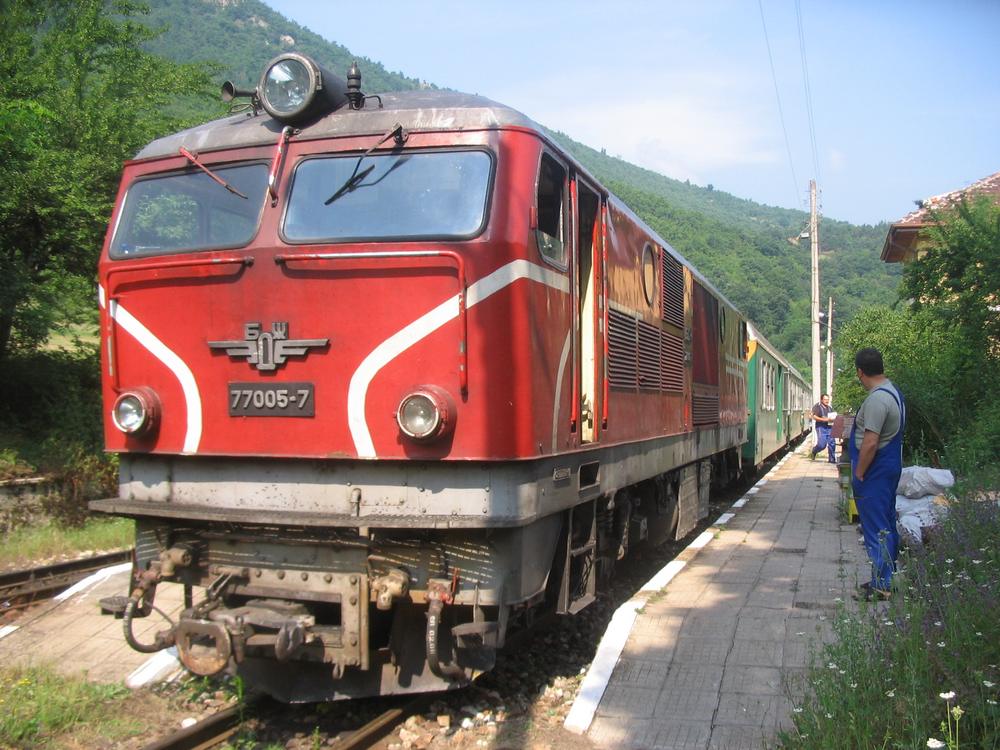

THE HOLY GRAIL of European travel seems to be the ‘new Prague’, as short break travellers seek the next ‘undiscovered’ city before Eire O’flot fills its streets with stag nights and the sort of Britons who inspire the rest of us to let people think we are from somewhere, anywhere, else.
Sofia isn’t it. However ancient a church is, once it is submerged in a roundabout it loses its appeal. Moving the national museum from the city centre to somewhere on the far side of the local equivalent of the M25 was a brave move, equalled only by the bravery of the people who try to cross the road to reach it.

A much better reason to visit Bulgaria is the country’s last surviving narrow gauge railway, a 125 km line between Septemvri and Dobrinishte in the southwest of the country which take passengers on an attractive 5½ hour journey through the Rhodope and Pirin mountain ranges.
The obvious place to start a visit to the line is Plovdiv, a city which was already old when it was trashed by Alexander the Great’s dad in 342 BC, before he modestly re-named it after himself. You can still clamber over ancient ruins in the UNESCO-listed old town to get a fine view over the city’s Ottoman mosques and communist concrete, and six of its original seven hills (one was getting in the way, so they removed it).

Bulgaria seems to be where German trains go to die, and the 08:15 departure from Plovdiv was no exception, still adorned with signs still telling us what was Verboten while the train was stopped in the Bahnhof.
Ties to Germany stretch back to the construction of the railway, which was undertaken by German financier Baron Hirsch under a concession agreement with the Ottoman empire. The line between Plovidiv and Septemvri opened in 1872, as part of a railway from Constantinople to Belovo built under a scheme to link the capitals of the Ottoman and Austro-Hungarian empires “not only in support of their imperialistic strivings, but also a factor for political consolidation against Russia”i. It was subsequently extended to Sofia and on to the Austro-Hungarian empire at Tsaribrod (now Dimitrovgrad in Serbia) from 12 August 1888, with the opening of this first line built after Bulgaria’s liberation from the Turks been seen as the birth of Bulgarian State Railways.
Septemvri boasts a large station building, and a café selling substantial spicy sausages with bread and dark beer which proved useful on our return the next day. Narrow gauge trains leave from an island platform, and, as ever, the tourists are easy to identify as they are to only people who bother to penetrate the Stygian depths of the subway to cross the main line. The narrow gauge station is pretty basic, with some staff accommodation and a dark room which passed as the loo – completely unlit, but that’s probably for the best.

Railways had come late to Bulgaria, and the initial 39 km of the narrow gauge line from Septemvri as far as Velingrad has just completed its 80th year, having opened in 1926. Construction began five years before, the relatively late construction start reflecting the historic lack of development in Bulgaria, a shortage of funds and the difficult terrain. Further complications came from the convoluted conflicts and border changes that the Balkans are infamous for, with the full area of the line only brought into the country during the First Balkan War in 1912, and further adjustments following the financially-damaging defeat in World War I. During the global conflict various 600 mm gauge lines had been built with German equipment to support the campaignsii, demonstrating the potential for reaching the parts other railways couldn’t, at a price which Bulgaria could afford. After some discussion as to whether sufficiently powerful locomotives could be produced to anything less than metre gauge, the government opted for developing narrow gauge lines using the 760 mm (2ft 6in) gauge which had proved successful in Bosnia and elsewhere.
Two substantial 760 mm gauge lines were built in Bulgaria, but the 105 km Cerven Briag – Oriahovo route closed in December 2002, leaving Septemvri – Dobrinishte as the last narrow gauge route operated by state railway operator BDZ. A greater loss from a tourist’s point of view is the 600 mm line which once linked the Sofia to Greece line at Kocherinovo with Rila and its famous monastery, which is Bulgaria’s foremost tourist attraction but rather difficult to reach without transport. A loco and coach from the line are preserved on the concourse of Sofia Tsentralna station, but I can’t help thinking that had the line survived beyond the 1960s until recent times, it would now be a very popular route.
Into the mountains

Along with a reasonable number of other passengers we hopped on the five-carriage train, and waited for departure at 09:12. The bogie coaches are second-class only and somewhat spartan, but do at least boast padded seats.
Behind the passenger platform are lines of derelict wagons, left over from the extensive freight traffic which unfortunately has now ceased. The route was built for 12 tonne axle loads, relatively high for a 760 mm gauge line, and the 1100 horsepower locos are said to be the most powerful of their gauge in the world. Timber from the forests along the line was a major source of traffic outwards, and construction materials and general goods were brought in from the rest of the countryiii.

The depot is visible on the right as the train departs, with a Soviet-built Class 81 shunter, and a rake of slightly more luxurious passenger stock sat above an inspection pit. There is also a standard gauge rolling stock works.

Turning southwest away from the main line to Sofia, 120 km away, the narrow gauge route follows the side of a road across the open plain between the Rhodope mountains to the south and the Balkan range to the north. The mountains were formed when Thracian bigwig Haemus unwisely compared himself and his wife the nymph Rhodope to Zeus and Hera, which annoyed the gods so much that they transformed the couple into the two mountain chains, forever separated by the River Maritsa.
Our train’s first significant stop is Varvara, which from 27 October 1928 until October 2002 was the junction for a 16 km branch which interchanged with the Septemvri – Plovdiv line further east at Pazardjik.

The railway then plunges into a rocky gorge marking the start of the Rhodopes, twisting alongside a road and the tumbling River Chepinska, nipping in and out of a series of short tunnels, some of which are replacements for an original alignment which was destroyed by earth movements in 1928. The Ladas and battered old buses on the parallel road have to give way at a barriered level crossing, then the railway jumps across to the other side of the river.
My friend’s FIP [an international scheme for reciprocal railway staff travel] pass flummoxed the guard when she came to check tickets, but it looked convincing enough to be accepted. She seemed excited at the sight of my EuroDomino pass, and then decided to walk off with it. To my relief she returned with a second member of staff, and we established that she had never actually seen a real EuroDomino before, so wanted to show it to a new employee who was also onboard.
EuroDominos make little financial sense in Bulgaria. The fares are as cheap as the trains are slow, and even travelling from one end of the country to the other every day is unlikely to cost as much as the pass. However it does remove the need to queue up to buy tickets, and means you don’t need to know where you are going (not surprisingly, booking clerks can get confused with requests for a ticket to wherever that big throbby diesel loco is going, please
). In theory most inter-city trains in Bulgaria require reservations, but on our first day in the country we’d visited three ticket windows at (the misleadingly named) Sofia Tsentralna station to get a slip of paper which no-one ever asked to see, and after that we didn’t bother, with no objections from anyone. The booking we did get specified a coach and seat, but as far as we could tell the coaches weren’t numbered anyway, so it was all a bit academic.
Dolene interlude
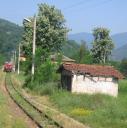
Road and rail eventually part company, the the gradient steepening as the railway heads off into a wooded valley. A sharp horseshoe curve brings the train to Dolene, a small station amid the trees about 21 km from Septemvri. The passengers spilled out for a wander outside or a cigarette, even though on many Bulgarian trains ‘no smoking’ simply means ‘open a window first’.

Lacking confidence in my ability to decode the dusty timetable on the station wall, I went to ask the guard if there was time for me to take some photos. She made train noises and waived her hands past each other to symbolise that we were waiting to cross another train, and when I waved my camera she said “da while shaking her head, so I knew I had time to wander off up the line to gets some shots. Bulgarians shake their heads for yes and nod for no, something which I’d suspected was either a travel book myth or a tradition which had fallen to globalisation, but I was happy to discover is true. The trick is to always say da or ne as often as possible, and try very hard not to move your head as you speak!
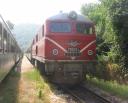
While the uphill train sits at Dolene for about 11 minutes, the downhill makes brief 2 minute stop, and the passengers waved to each other as they passed, a group of kids being particularly keen to ensure they were included in our photos. The other train was hauled by one of the 10 B-B diesel-hydraulic locomotives which were ordered from Henschel in Germany to replace steam in 1965. Attractive machines, they are based on a metre gauge design supplied to Spain, Thailand and Togo.

Our train was pulled by a similar but Romanian-built Class 77 loco. These were built by the 23 August factory in Bucharest in 1988 as an improved version of its Class 76 locos, which had suffered from various problems and are now all withdrawn. Following a drop in freight traffic five of the Class 77 locos were sold to the Rio Turbio Railway in Argentinaix
Climbing the side of the valley, the Septemvri-bound train is occasionally visible between the trees in the valley below.
The spa town of Velingrad boasts 80 hot springs with waters to cure all kinds of ailments, as well as a large station where many passengers got on or off. The abandoned goods yard has an assortment of derelict open, van and flat wagons cluttering the sidings, along with an almost comic-looking 760mm gauge Plasser tramper.
One of the passengers boarding at Velingrad was a retired teacher of German, who gave us a commentary on the next stretch of the line, opened from Velingrad over the Rhodope ridge to Jakoruda in 1937. He’d hoped we were German so he could chat to us, but unfortunately my German is much too limited, and all we really understood was that there was a chance of seeing some eagles on the cliffs high above the line.
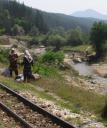
Many of the stations are excessively substantial for today’s traffic, and the train almost emptied at Cvetino, where we passed another downhill train. The diminutive guard clambered up on a radiator to be able to lean out the window and wave her flag, and then we left for a further section of river gorge, passing between the Rhodope and Rila mountains though countryside once frequented by Orpheus, of underworld fame.
With the departure of the teacher at Cvetino, we raided the food supplies we’d acquired from a kiosk outside Plovdiv station. The station stops on the line are fairly short, and some are rather remote, so there is little chance of acquiring food en route. Bulgarian kiosks offer a wide variety of banitsa, pastries in a range of different shapes and sizes, all tasting like cardboard smeared with grease and marinaded with cling film. There is also a mysterious and foul-smelling brown cereal drink, which we both found undrinkable but is strangely popular with the locals.

I’d started keeping a close eye on my bottles of water after someone sharing our compartment on a train to Varna used my drink it to jam the train window open and try to get some ventilation. A much cleverer trick which is widely employed is to keep your worldly goods in a carrier bag tied to the window handle, with the weight holding the window open against the invariably broken mechanism.
After the deluge
On August 4 2005 Bulgaria was hit by severe flooding, Railway Transport Magazine describing a ‘crisis was so overwhelming that previous floods seemed as innocent as a children’s game in a swimming pool’. The Sofia – Plovidv main line was out of action for a month, and it took four days to restore a partial service on the narrow gauge line after the ‘most devastating disaster’ in the 117-year history of Bulgarian railways.

The waters carried with them inevitable talk of abandoning the line, but on September 15 through services resumed following work to shore up embankments and install concrete flood defences between Cvetino, Avramovo and Cherna Mesta.iv The low running speeds were further cut by temporary speed restrictions throughout the damaged areas, trains crawling across some precarious- looking track over what must have been quite spectacular wash-outs.
The scenery gets increasingly impressive as the line zig-zags up the hills on gradients which reach 1 in 33, and the fragrances of the pine forests and carpets of local purple, yellow and sometimes white flowers fill the train. At one point three short tunnels in quick succession give an interesting view out the back of the train and through all three bores at once, and plunging into one of the longer chasms highlighted that the lighting in our carriage was defunct.
The train pauses briefly at Avramovo, 68 km from Septemvri and proudly announced as the highest station in the Balkans. Our friend the teacher had told us to watch for this, and the guard came along to ensure we saw the notice declaring that we were 1267 m above sea level. Much of the station signage along the route is bilingual, in Bulgarian and, strangely, French. The station appears to have little else to commend it, and the journey continues.

The Rhodopes remained outside Bulgaria when she gained her independence in 1878, but were added to the territory in the First Balkan War of 1912-13, and the railway helped to ensure the area would look north towards Sofia and Plovidv, rather than south to the Aegean ports. There is still posses an exotic feel, as headscarfed women in brightly-patterned dresses board the train, which threads past gleaming white mosques and minarets in the villages inhabited by ‘Pomaks’, ethnic Slav Muslims.
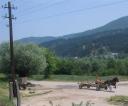
Horse-drawn traffic is quite common, the wagons drawn by horses decorated with red pom-poms on their heads. One cart driver decided to race the train, keeping up with us for a minute or two before we got ahead.

The line flattens as it reaches the Mesta valley, and the Pirin mountains come into view, still capped with snow in June. 114 km from Septemvri is Razlog, an industrial town with a paper factory which was once a major source of traffic for the line, employing three diesel locos until 2003v.

The loco is swapped for a replacement at Bansko, which is 118 km from the start of the trip, 936 m above sea level, and the main target of the line. However we stayed on-board to complete the route, having the train almost to ourselves for a further 13 min as far as the terminus at Dobrinishte, 125 km and 5½ hours from Septemvri. This final 7 km section of the line opened in December 1945 and is worth doing if you want to colour it on on your map, but offers little excitement in itself.

The timetable gives the option of not quite long enough or far too long in Dobrinishte, and as nothing exciting was visible from the station forecourt we contented ourselves with a few photos. Two more passengers appeared for the 15:00 return journey, equipped for serious hiking with military style gear but also photographing the train from all sides. We couldn’t identify their language, but they were using another railways staff passes, so of the four passengers on the return leg, I was the only one with a paid-for ticket – and even that was a pass, which can’t be too good for the traffic statistics.


Bansko has a small locomotive shed, and dumped (or preserved?) outside are two steam locos which we cabbed, plus a derelict diesel multiple-unit, all displaced by the arrival of the powerful Henschel diesel locos in 1965. We double-checked the next day’s departures on the timetable board, a slightly cryptic listing which includes the time times the various service leave their initial stating point, as well as the station in question. The Cyrillic alphabet initially looks a bit scary to someone with my lack of linguistic ability, but once you get the hang of transliterating a few letters it is fairly easy to spot what you are looking for. It is usefully phonetic, and the locals could generally understand what we were trying to say, as long as we remembered to not to shake or nod our heads!
Time for tourism
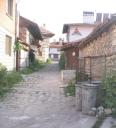
Bansko is a pretty place of cobbled streets and wooden houses, if a little over-modernised in parts. Property investors are hoping it will overtake places like Poland’s Zakopane as the eastern European ski resort of choice, and signs for estate agents’ offices line the streets, just as adverts for Bansko fill the windows of London estate agents. The winter sports areas are some way from the town, and new developments are sprouting up to serve the pistes.

Tourism has firmly arrivedvi, with a selection of restaurants offering alleged local colour and menus available in multiple languages (after a fashion – I opted for a Tickle of the Boss, having decided against Chicken Levers or Cock appetizer). Roadside stalls sell ice cream by weight, and a quid’s worth makes a fine site in the blazing heat.
The accommodation was less of a success, with Hotel Alpin believing that the addition of a sofa-bed was enough to declare the room as a twin, and breakfast seemed to be advertised in purely for decorative purposes.

A ski resort in summer is never going to the most exciting place, so we called it a night early and decided to forgo another bland Bulgarian lager in favour of catching the 06:13 train the next morning, which had the advantage of getting us to Septemvri by 11:10, from where we caught the 12:39 departure for Sofia, arriving at 14:34.
Two elderly couples got on for the last stretch of the trip down to Septemvri, and the men launched into an impromptu performance of Bulgarian songs. There was more enthusiasm than harmony, but all the passengers listened intently to what must be well-known tunes.
Worth a ride

The narrow gauge line is well worth the ride, though with just two or three through trains a day taking 5½ hours uphill and 5 back down there is a risk of too much of a good thing. In theory a day trip could be possible from Sofia, but I doubt even the most committed railfan would find the necessary early start and late return would constitute much of a pleasure by the time he was back in Sofia. A two day trip is a more realistic option, with both Bansko and Plovdiv being pleasant places to stay.
The times of the trains aren’t ideal for tourists, but in summer the early morning train does avoid the worst of the heat. The future of the line has been in doubt in recent years, and upgrades to the roads won’t help, but the repairs after the flooding suggest that the railway could still have a role; it was certainty well used. In December 2005 the local councils of the towns served by the line put forward a proposal for it to be operated under a concession, and negotiations have been held with British and German tour operators in the hope of capitalising on the scenic attractions of the line to develop tourist traffic.
Bulgaria’s trains are slow, infrequent and grubby, but there is still a sense of occasion to travelling. Racing horse drawn carts on 2’6″ gauge trains which wind between mosques is well worth doing before things change, whether for better or worse.
| Opening datesvii |
| |
Parliamentary approval |
25 September 1920 |
| |
Construction starts |
1921 |
| 39 km |
Septemvri (then called Sarambey) – Varvara – Velingrad (at the time three separate villages) |
1 August 1926 |
| 16 km |
Varvara – Pazardjik branch |
27 October 1928 |
| closed October 2002 |
| |
Velingrad – Velingrad YG |
1 July 1927 |
| 47 km |
Velingrad YG – Jakoruda |
12 December 1937 |
| 15 km |
Jakoruda – Belica |
30 July 1939 |
| 18 km |
Belica – Bansko |
30 March 1943 |
| 7 km |
Bansko – Dobrinshte |
9 December 1945 |
A branch from Kostandovo to Batak and a continuation of the main route beyond Dobrinishte to Gotse Deltchev (then called Nevrokop) were approved but not built.viii
The names of settlements along the route have varied with growth, politics, and the chosen scheme of transliteration from Cyrillic. For the sake of simplicity, I’ve used the spellings adopted by the Deutsche Bahn journey planner which we all know and love.
References
So you don’t have to take my word for it!
i 100 Years Bulgarian State Railways, BDZ, 1988 [A commemorative book produced just before changes swept eastern Europe. A typical excerpt: the revolutionary traditions of the railwaymen are best manifested during the armed struggle against the Hitlerite invaders and the Bulgarian fascist bourgeoisie
]
ii The Bulgarian State Railways, S H Beaver, The Railway Gazette, 26 June 1936 pp1204-1207
iii Narrow gauge locomotives of great hauling capacity, The Railway Gazette, 1 July 1966 pp524-526
iv Flooded again! T Stefanova, Railway Transport Magazine, September 2005
v Bulgarian railways today, C Bailey, Today’s Railways Europe No.132, December 2006
vi The Rough Guide to Bulgaria, J Bousfield, D Richardson
Links


























